Carolyn Baker, clad in a neon pink top and matching sunglasses, smiled as she ran the Falmouth Road Race on the shore of Cape Cod, looking around for friends as she neared the end of a race she’d completed more than a dozen times before.
Suddenly, Baker collapsed, as her exertion on a sunny August day sent her internal temperature soaring. As medical volunteers rushed to her aid by plunging her into a tub filled with ice water, they measured it at nearly 107 degrees (41.6 Celsius).
For family members, the first sign of trouble was when their tracking app showed Baker moving backward on the course—as she was taken to the medical tent. Her husband, catching up with friends after finishing earlier, blurted “Oh my god,” after his daughter called to alert him, then rushed to the tent.
The heatstroke that felled Baker last year is a deadly illness associated with extreme heat, and climate change is worsening the risk. In the continental U.S., the frequency of dangerously hot days is expected to grow by roughly one-third by mid-century.
Exertional heatstroke happens during exercise when the body can’t properly cool, rising above 104 degrees (40 Celsius) and triggering a central nervous system problem such as fainting or blacking out. It can be effectively treated by rapidly cooling a victim, but lots of races lack the resources or expertise to do it. And many runners, in a culture that esteems grit and suffering, may ignore conditions that put them at risk.

Muscles can break down, releasing proteins that damage kidneys. The lining of the digestive system may weaken and leak bacteria. Brain cells may die. It can damage organs and, ultimately, kill.
The Falmouth race is a magnet for heatstroke. At 7 miles, it’s long enough to give the body time to heat up dangerously and short enough that many runners are pushing hard. And with more than 11,000 runners, odds are good that some haven’t trained to acclimate to hot weather, or show up dehydrated. And some runners are simply more vulnerable.
But if you are going to have heatstroke, you could do it in a worse place than Falmouth. They have enough people, equipment and experience to handle lots of cases. And medical director John Jardine has documented nearly 500 cases of heatstroke in more than two decades—so many the race has attracted researchers.
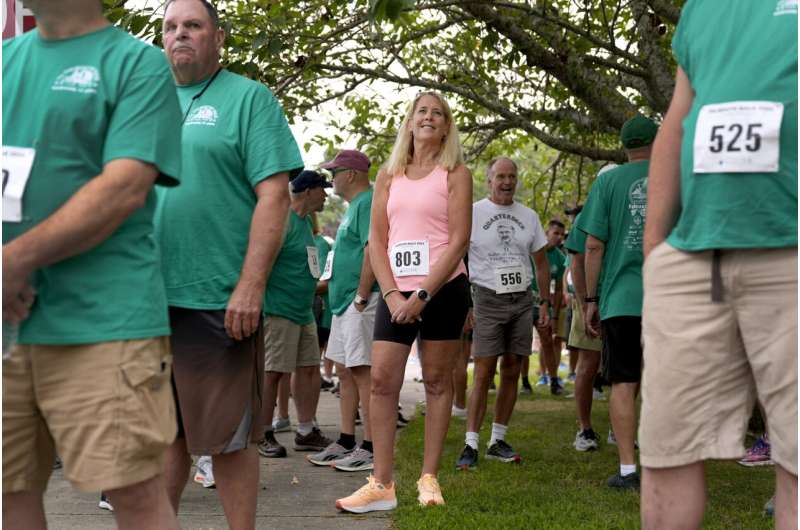
The problem is lots of races don’t have the equipment or expertise to offer the right lifesaving care, said Douglas Casa, director of the University of Connecticut’s Korey Stringer Institute, named for the Minnesota Vikings lineman who died of heatstroke in training camp in 2001.
“Think of the local 5K races,” Casa said. “They might have an ambulance there or they might have a nurse or medic or somebody there, but they don’t have a whole medical tent set up to be able to deal with heatstroke.”
Keeping runners alive
Getting victims into a tub of ice water is the best way to quickly cool them. And it needs to happen fast, with quick diagnoses to treat runners on the spot. Medical staff need rectal thermometers to gauge temperature when skin can be deceptively cool.
“I can’t guarantee everything that is going to happen in the future,” Casa said. “But based on over 3,000 cases we’ve tracked, if someone’s temp gets under 104 within 30 minutes of the presentation of heatstroke, no one has ever died.”

He said there isn’t good data on how many races do it right. From his decades of experience, very few do, although generally he said care is better now than when he started. Casa suggested governing bodies for racing should publish heat-related recommendations for safety.
Race directors must organize complex events for runners of all ability. Some are big races with lots of resources; others are small local affairs with a shoestring budget. Security, organizing workers and volunteers, tracking runners and medical care all must be assembled and paid for, said Dave McGillivray, who helps direct the Boston Marathon and also advises other race directors.
Runners bear responsibility, too. He recalls grabbing a mic at the 2012 Boston Marathon when it was apparent the day was going to be hot, telling runners they needed to take it easy. It’s a hard message for runners who have trained months to meet goals.
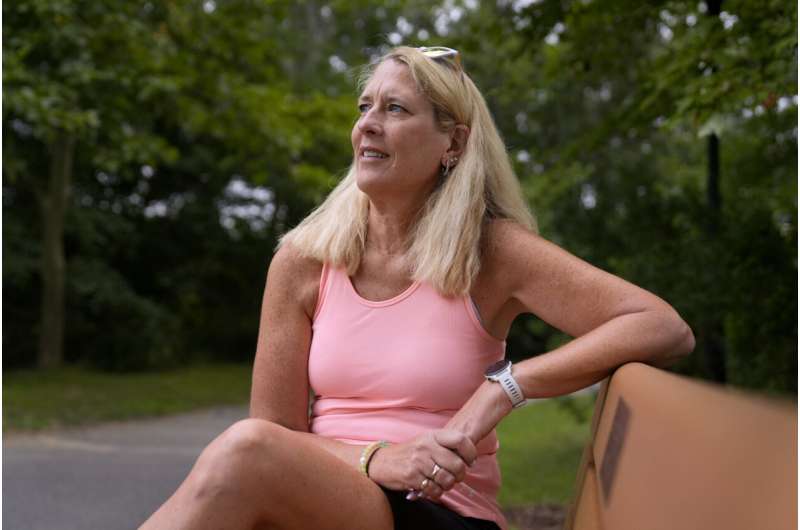
“We cannot fit all of you in our medical tents,” he remembered saying. More than 2,000 people needed treatment that day; roughly 200 went to the hospital.
“It was a lot of carnage out there,” McGillivray said. “But, you know, no one passed, people went home, and we dodged the proverbial bullet. Not every race can say that. If you don’t have the resources, then you shouldn’t be firing the gun.”
Two athletes’ stories
Evan Hauptmann, a multi-sport athlete in high school, decided to run Falmouth at 17. He wanted to finish in under an hour and felt fine until a big hill late in the race made him light-headed. By then he could see the finish line and his competitive nature kicked in.
Soon after finishing, he lost consciousness. His temperature was the highest Jardine has seen at Falmouth—112.8 degrees (44.9 Celsius).
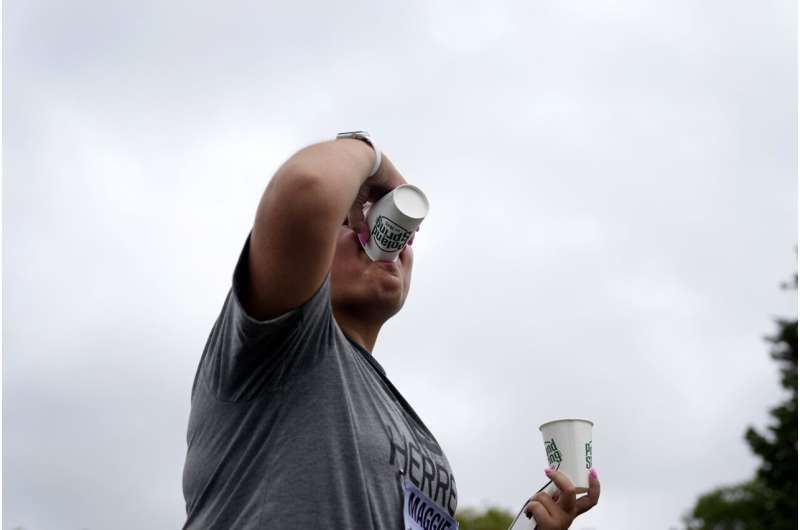
“That’s crazy,” said Dr. Sameed Khatana, a professor of medicine at the University of Pennsylvania. “That is not compatible with life.”
But Hauptmann got immediate care, with a half-hour in the ice bath bringing his temperature down quickly, and he went home that day. Doctors worried about organ damage. Blood tests showed high protein levels from muscle breakdown, but they came down and he avoided lasting injury.
Two weeks later he started playing football again. But he’s more aware of heat’s danger, and makes sure to stay hydrated and aware of how he is feeling.
“As an athlete I can’t really let it stop me from competing,” he said. “I kind of just have to learn from it, realize what I did wrong and realize what I can do better in the future to listen to my body.”
In contrast, there’s Zoë Wallis, recruited to play college basketball in South Carolina. The summer before her freshman year in 2014, her team was told their mental strength would be tested with a 5-mile run they had to finish within an hour. It was about twice as far as she had ever run.

By the second half, she started feeling hazy, then panicky. Eventually, a teammate on each side held her up. She recalled saying she wanted to stop but being pushed forward.
“What I remember happening was getting a jolt of energy near the end and feeling like I was hitting this runner’s high and was going to finish the run strong,” she said. “In reality, what happened is that I completely collapsed, skinned my entire arms, elbows, knees.”
She was taken to the hospital in a car, laid across the warm laps of teammates. She awoke in the emergency room, disoriented. Her kidneys and liver had failed, she said. She eventually sued the school and receive a settlement.
Wallis said it took about three months to resume practice. But the sport never felt the same. Eventually, she left the team, lost her scholarship and transferred.
“The mental aspect of the heatstroke consumed me. I felt so fragile, not only when I was practicing and actually playing my sport, but also just existing. I was just afraid in so many ways,” she said. Ten years later, she’s in a good place, but it took therapy and time.

Keep running, but be smart about it
Racing may slightly increase the chances a runner will suffer a rare event like heatstroke or cardiac arrest, but doctors say it’s almost certainly healthier to show up anyway.
“Runners and athletes are at reduced risk of having not only cardiac arrest, but all forms of heart disease compared to non-runners,” said Dr. Aaron Baggish, a professor at the Université de Lausanne and former medical director of the Boston Marathon.
Baker, now 61, had a happy ending.
She regained consciousness in an ice bath that brought her temperature down to a safe level. Her head hurt and she felt weak, but family members eventually helped her stand and she was able to go home. She had no memory of her collapse, and called it “eerie” afterward when she came upon a gallery of race pictures online and saw photos that showed her falling to the ground.
-

Race medical director Dr. John Jardine takes part in a planning phone call on Saturday, Aug. 17, 2024, a day before the annual Falmouth Road Race in Falmouth, Mass., as tubs used to cool overheated runners on race day are seen inside the finish line medical tent. Credit: AP Photo/Jeff Roberson
-

Runners grab water near the 3-mile mark in the Falmouth Road Race, Sunday, Aug. 18, 2024, in Falmouth, Mass. Credit: AP Photo/Jeff Roberson
-
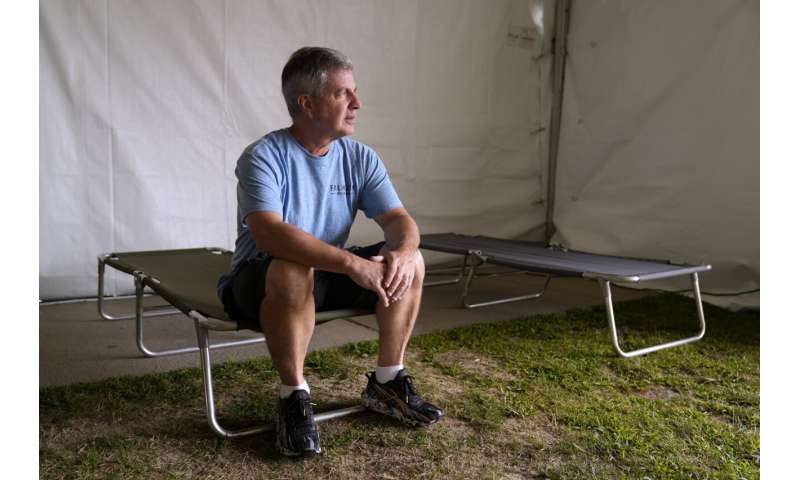
Race medical director Dr. John Jardine poses for a photo in the finish line medical tent on Saturday, Aug. 17, 2024, a day before the annual Falmouth Road Race in Falmouth, Mass. Credit: AP Photo/Jeff Roberson
-

Race medical director Dr. John Jardine, right, and medical coordinator Chris Troyanos get an update on the weather forecast during a planning phone call inside the finish line medical tent on Saturday, Aug. 17, 2024, a day before the annual Falmouth Road Race in Falmouth, Mass. Credit: AP Photo/Jeff Roberson
-
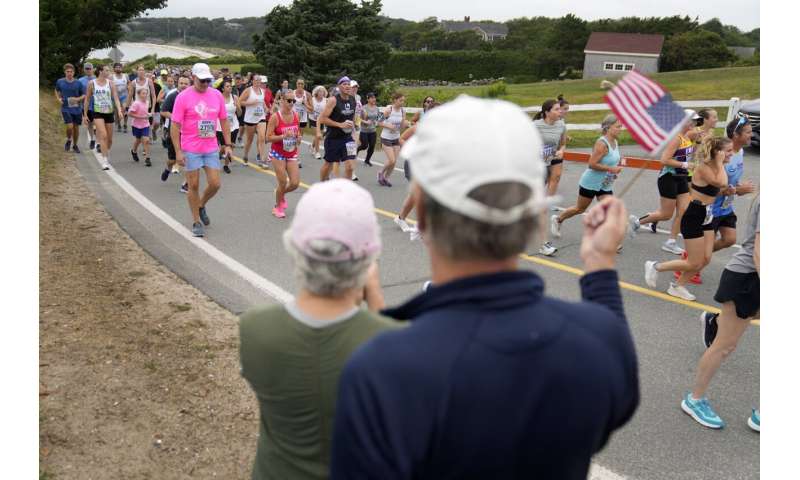
Spectators cheer on runners as they compete in the Falmouth Road Race, Sunday, Aug. 18, 2024, in Falmouth, Mass. Credit: AP Photo/Jeff Roberson
-

Medical workers Michael Powers, right, and Timothy Seaman watch runners cross the finish line in the Falmouth Road Race, Sunday, Aug. 18, 2024, in Falmouth, Mass. Credit: AP Photo/Jeff Roberson
One week later, Baker dressed in the same pink top, sunglasses and racing bib to run Falmouth’s last mile, striding past the spot where she collapsed. Her husband’s photos show her smiling and flexing at the finish.
“We have a big running group of friends and family,” Baker said. “Everybody in our group had finished the race except for me. And I was like nah, I need to do it. And I need to know I’m going to be OK mentally.”
This year, she was back at Falmouth again—and finished safely.
© 2024 The Associated Press. All rights reserved. This material may not be published, broadcast, rewritten or redistributed without permission.
Citation:
Runners are used to toughing it out. A warming climate can make that deadly (2024, August 30)
retrieved 31 August 2024
from https://phys.org/news/2024-08-runners-toughing-climate-deadly.html
This document is subject to copyright. Apart from any fair dealing for the purpose of private study or research, no
part may be reproduced without the written permission. The content is provided for information purposes only.


